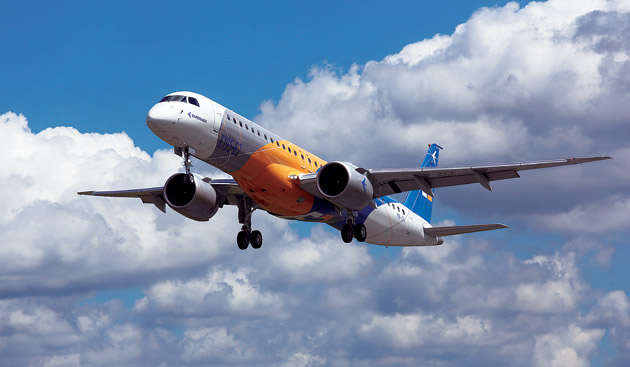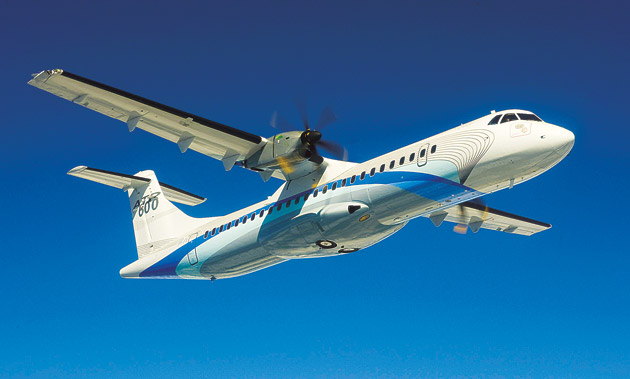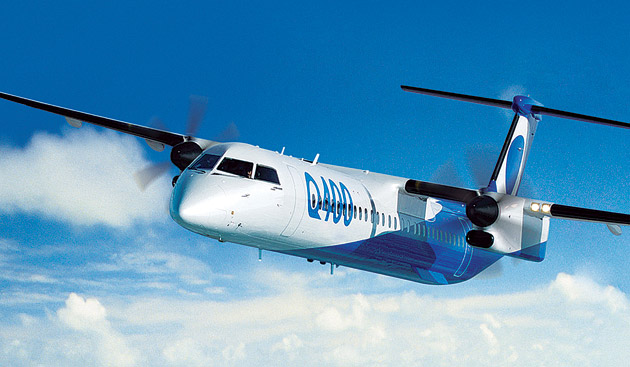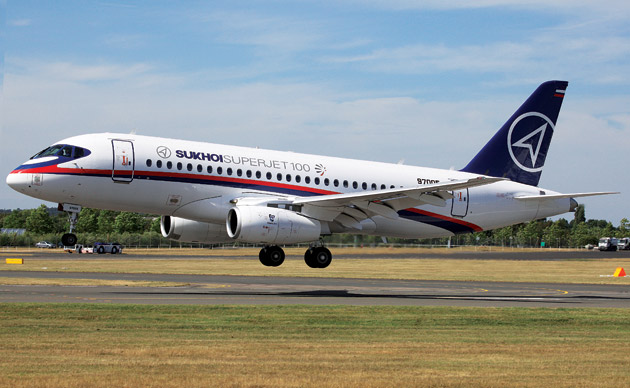Regional Aircraft Market Abuzz with Activity
The trend for mid- and long-haul operations will continue towards using jet aircraft over turboprops

Embraer Commercial Aviation in its 2017 outlook has forecast that the 70 to 130 plus seat regional jet would be the fastest growing segment during the next two decades and there would be a demand for 6,400 new jets of this seat category, with 4,100 being in the 90 plus category and 2,300 being in the 70 to 90 category. The combined market value equates to $300 billion.
The 70- to 130-seat jet world fleet-in-service will become the fastest growing aircraft segment, with an increase from 2,670 in 2015 to 6,690 in 2035. Replacement of ageing aircraft and new market growth represents 37 per cent and 63 per cent respectively.

As regards turboprops, Embraer forecast that there would be a worldwide demand for 2,040 turboprops of 70-seat category by 2035. Some 65 per cent of it is being attributed to market growth and 35 per cent to replacement of ageing aircraft. The trend for mid- and long-haul operations will continue towards using jet aircraft over turboprops. This is because of the former’s overall operational efficiency, cabin comfort and schedule compatibility with narrow-body jets in hub-and-spoke networks.
E-Jets E2 to lead the pack
The Embraer E-Jet family is a series of narrow-body medium-range twin-engine jet airliners, carrying 80 to 124 passengers commercially, manufactured by Brazilian aerospace conglomerate Embraer. Launched at the Paris Air Show in 1999, and entering production in 2002, the aircraft series has been a commercial success primarily for its safety and efficiency. The aircraft is used by mainline and regional airlines around the world.
In 2013, Embraer announced a $1.7-billion programme to remodel its E-Jets regional aircraft, to offer 16-24 per cent lower fuel-burn rates and 15-25 per cent lower maintenance costs. The three variants — E175-E2, E190-E2, and E195-E2 — have a common fuselage design but different lengths, and each has a different wing design. The jets are powered by Pratt & Whitney PW1000G geared-turbofan engines.
The Embraer E-Jets line is composed of two main commercial families and a business jet variant. The smaller E170 and E175 make up the base model aircraft. The E190 and E195 are stretched versions, with different engines and larger wings, horizontal stabiliser and landing gear structures. The 170 and 175 share 95 per cent commonality, as do the 190 and 195. The two families share nearly 89 per cent commonality, with identical fuselage cross-sections and avionics, featuring the Honeywell Primus Epic Electronic Flight instrument system. All E-Jets use four-abreast seating (2+2) and have a “double-bubble” design, which Embraer developed for its commercial passenger jets, that provides standup headroom. The E-Jets have turbofan engines designed to reduce noise, which allows them to operate in airports that have strict noise restrictions, such as London City Airport.
THE 70- TO 130-SEAT JET WORLD FLEET-IN-SERVICE WILL BECOME THE FASTEST GROWING AIRCRAFT SEGMENT, WITH AN INCREASE FROM 2,670 IN 2015 TO 6,690 IN 2035
Now that the E190-E2 is flying, the other E2s are starting to take shape. On March 29, Embraer’s largest commercial jet took off on its maiden flight, from the runway at the São Josédos Campos facility, ahead of schedule. The flight kicks off the start of the E195-E2 certification campaign in which two aircraft will be used — one for aerodynamic and performance tests, the other to validate maintenance tasks and the interior. The second E195-E2 is scheduled to fly by the end of this year. The first E195-E2 is planned to be delivered to Azul Linhas Aéreas Brasileiras in 2019. The E195-E2 is the last and largest of the E-Jets E2 series of medium-range aircraft, the first of which will be delivered next year.
ATR world leader in turboprop
Toulouse, southern France-based turboprop aircraft manufacturer ATR, is the world leader in the market for regional aircraft up to 90 seats. Established in November 1981, ATR is a joint partnership between two major European aeronautics players, Airbus and Leonardo. ATR has sold more than 1,500 aircraft and has over 200 operators in over 100 countries. Every eight seconds, an ATR turboprop takes off or lands somewhere around the world.

ATR manufactures two sizes of turboprop aircraft, the 70-seat ATR 72 and the 50-seat ATR 42. Both aircraft benefit from fuel, emissions and cost efficiencies provided by turboprop engines. ATR turboprops provide airlines with the best opportunities for operating short-haul routes at a low operating cost. Airlines servicing smaller markets desperately need more fuel efficientaircraft to continue operating regular flights between regional airports and to main airports and hubs.
Bombardier benchmark in regional jet efficiency
For medium-haul applications, the CRJ Series family of aircraft is the benchmark for regional jet efficiency in the 60- to 100-seat segment, offering up to a 10 per cent cash operating cost advantage, reduced environmental impact and enhanced cabin interiors. With over 1,900 CRJ Series aircraft ordered worldwide, Bombardier’s CRJ Series family of regional jets is recognised as the most successful regional aircraft programme in the world. The CRJ Series performance on reliability is over 99.5 per cent thanks to its mature systems and robust technology.
The CRJ Series shares commonality benefits from being an integrated family, providing flexibility to operators and allowing them to optimise their fleet to specific market demands. No other regional aircraft delivers this capability.
The Q400 offers the best of both worlds: able to either fly slower to minimise fuel burn or faster to maximise productivity. At lower speeds, it offers the same trip cost as competing turboprops, with up to 14 more seats. At higher speeds, the Q400 delivers over 30 per cent cost advantage compared to the jet aircraft it often replaces.
Simply put, the Q400 has the lowest fuel consumption per passenger of any turboprop in the industry, making it an efficient and greener option. On a 500 nautical mile journey, the Q400 consumes 3 litres of fuel per seat per 100 km, which is comparable to any other modern next-generation aircraft flying today. Inside and out, the Q400 has been continuously improved to make it the largest and most comfortable turboprop in the world. Passengers enjoy a quieter cabin thanks to the Q400’s unique Active Noise and Vibration Suppression system, which results in noise levels lower than those of some jets.
MRJ clean sheet and more
The Mitsubishi Regional Jet started with a clean sheet and ended up with a new benchmark. It began with a goal—to change the way the world thinks about regional aviation. It is designed to incorporate superior technology and passenger comfort and engineered to achieve the lowest operational cost and lowest environmental impact. MRJ states that it will change the way passengers fly and it is better for passengers, the environment and airlines. It promises to be the most efficient, comfortable and reliable 70- and 90-seat jets to ever take flight.

It also claims that it is the lowest cost to operate of any aircraft in its class. MRJ is powered by Pratt & Whitney’s PurePower Geared Turbofan engine which was optimised specifically for the MRJ. The new gear system allows the fan, low pressure compressor and turbine to rotate at optimum speeds which enables engine to have game-changing fuel efficiency. In addition, its Geared Turbofan engine architecture requires 60 per cent fewer turbine airfoils than conventional turbofan engines and reduces maintenance time and cost.
Sukhoi Superjet 100 optimised design
SSJ100 from Sukhoi is the first airliner in which engine and airframe have been designed together to optimise performance. The SSJ100 – a fusion of Russia’s famed aviation design and production skills with the latest systems from leading aerospace suppliers around the world – offers standards of economy, performance, environmental efficiency and passenger comfort never before seen in a 100-seat airliner.
ATR TURBOPROPS PROVIDE AIRLINES WITH THE BEST OPPORTUNITIES FOR OPERATING SHORT-HAUL ROUTES AT A LOW OPERATING COST
The SSJ100 aircraft entered into commercial operation mid-2011. Up until March 2016, it had delivered 78 SSJ100’s. To date more than 1,50,000 flight hours and more than 1,05,000 flight cycles have been accumulated worldwide by the SSJ100 flying fleet. In 2012 the SSJ100 achieved the European Aviation Safety Agency (EASA) type certificate. The aircraft is also certified by Russian IAC AR as well as by Indonesian, Laos and Mexican Civil Aviation Authorities. In January 2016, the SSJ100 was Cat IIIA certified by EASA. Its order book stands at 154.
The ‘Flying Phoenix’ from China — ARJ21
The Comac ARJ21 Xiangfeng which means ‘flying Phoenix’ is a twin-engined regional jet, manufactured by the Chinese aerospace company Comac. On November 29, 2015, Comac delivered the first ARJ21-700 to Chengdu Airlines. The first commercial flight took off from Chengdu Shuangliu Airport on June 28, 2016, landing in Shanghai two hours later, one day after its commercial flight was approved by the CAAC. Different sources claim the ARJ21 closely resembles either the McDonnel Douglas MD-80 or the MD-90 which were licenceproduced in China. Chinese factories producing parts for the MD-90 went on to produce the ARJ21 using tooling retained after the end of the MD-80/MD-90 licensed production programme, however, China claims that the ARJ21 is a completely indigenous design.
The regional aviation market is abuzz with turboprop and jets and there is considerable traction for the emerging players as they see opportunity in many markets which are networking their domestic destinations like never before.





